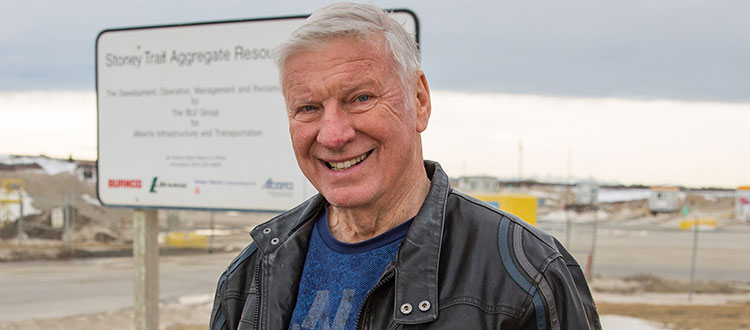
Feb. 07, 2017 | Joel Schlesinger
The Grumble Over Gravel
Rocky View's proposed gravel pit policy has local homeowners crying foul
Gravel hardly seems like a subject to stir controversy, but a proposed policy plan for gravel pits in Rocky View County has done just that.
Since the draft of Rocky View County's Aggregate Resource Plan was announced last year, it has raised the ire of residents in areas close to existing and possible future gravel operations.
In the midst of being finalized, the county states the aim of the plan is to create a framework to develop the region's ample deposits while protecting the well-being of its citizens.
Yet some homeowners in the county are skeptical of the plan, arguing it pays lip service to concerns about the potential dangers to public health and the possible negative impact on residential property values.
"The current draft is pretty much biased toward industry," said Mike Edwards, who lives on a two-acre Crestview Estates property in Bearspaw, about a kilometre northwest of Calgary's city limits.
"We've been fighting this stuff for decades."
Proposals to develop a gravel pit operation adjacent to the community were rejected twice in the last three decades. Now Edwards and other residents are concerned the new policy — in its current draft — would make it too easy for proposals for new operations to get the stamp of approval from council.
"We think it's already a problem in the area," he said, adding his neighbourhood is about three kilometres away from an existing operation, one of about a half dozen operating in and around Calgary.
"In the summer we hear the noise from the crusher going 24/7, and you can't sleep with your windows open," he said, adding that he believes the dust from operations poses a serious health hazard.
Gravel in the region is high in silica, a known carcinogen. Silica has been linked to a serious lung disease called chronic silicosis, according to the Alberta Municipal Health and Safety Association.
"We've been fighting this stuff for decades."
While operators must take measures to mitigate air pollution and dust, such as using water trucks, Edwards says it doesn't make a difference.
"Whenever the wind comes up, the dust just swirls up with it," said Edwards.
Grant Kaiser, spokesperson for Rocky View County, said they can't comment on the draft policy until public consultations wrap up in mid-February as they "do not wish to influence public input."
However, he did confirm that open houses have been well attended so far, with dozens of residents voicing concerns.
Kaiser added the plan was devised to support "the extraction of natural resources in a manner that balances the needs of residents, industry and society."
Geological surveying reveals the area to be rich in gravel deposits. Moreover, demand for gravel across Alberta is high.
John Ashton, executive director of the Alberta Sand and Gravel Association, says gravel is an essential resource for construction industry, including homebuilders.
"Every house requires approximately 160 tonnes of gravel," he said, adding that Calgary region home builders use an estimated two million tonnes annually.
Rocky View — because of its proximity and its abundant natural deposits — is considered critical to the industry.
Ashton adds that the county has a good track record of environmental stewardship when it comes to extracting gravel. Depending on council's decision regarding development of future resources, he says the county could play an even larger role in Calgary and the surrounding municipalities' growth for decades to come.
Edwards says that concerned residents understand the importance of the resource, but they want to see any policy regulating gravel extraction to address their concerns, including the possible negative effect on property values. He points to an Auburn University study that found property values can decrease anywhere from about five to almost 30 per cent as a result.
As the draft currently stands, Edwards says the setbacks for an operation from an existing structure, including a home, would be 500 metres in most cases, but could be reduced to 100 metres in certain situations.
"There's too much ambiguity," he said, adding other municipalities have setbacks of 1,500 metres.
"But the big issue is that the plan totally favours gravel and not the people."
Since 2006, existing operations have provided about $10 million in revenue to the county through a levy. These funds have been mostly used to help maintain and expand affected roads.
Rocky View County Council is expected to vote on the plan this March.
Tagged: Bearspaw Real Estate | Policy | Rocky View County | Surrounding Areas




